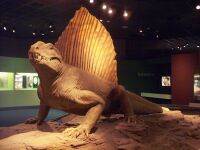| Dimetrodon | |
|---|---|

| |
| Scientific classification | |
| Kingdom Information | |
| Domain | Eukaryota |
| Kingdom | Animalia |
| Subkingdom | Bilateria |
| Branch | Deuterostomia |
| Phylum Information | |
| Phylum | Chordata |
| Sub-phylum | Vertebrata |
| Infraphylum | Gnathostomata |
| Class Information | |
| Superclass | Tetrapoda |
| Class | Reptilia |
| Order Information | |
| Order | Synapsida |
| Family Information | |
| Family | Sphenacodontidae |
| Sub-family | Sphenacodontinae |
| Genus Information | |
| Genus | Dimetrodon |
| Population statistics | |
Dimetrodon refers to several species of extinct synapsid reptiles of the family Sphenacodontidae, whose fossil remains have been found principally in North America. Evolutionists believe it to be a transitional form and that synapsids were the ancestors of modern mammals, but evidence shows Dimetrodon to be fully reptilian.
Description[edit]
Dimetrodon was large, about 6 to 15 feet long, and weighed approximately 60 to 550 pounds. It was lizard-like in appearance and overall build, with a long tail, clawed feet, and a deep, blunt head and snout. The name "dimetrodon" described the teeth; when paleontologists first found and described the animal they noticed the differing, almost mammal-like teeth and gave it the name which, from the Greek, means "two measures of teeth" (δύο μέτρα δόντια).
The striking feature it bore was a large back sail, composed of the elongated spinal processes of the vertebrae of the trunk and cervical spine and covered in skin. The current theory of this feature was to allow the animal to regulate its body temperature. In order to warm the body more quickly, Dimetrodon, according to this theory, turned its flank towards the sun, which warmed the blood flowing into the sail and allowing the animal to warm up quickly. In a 1973 paper, C.D. Bramwell and P.B. Fellgett calculated that a dimetrodon weighing 440 pounds could increase its body temperature from 78.8° C to 86° F in 80 minutes with its sail[1], compared to 205 minutes without it. Although competing theories have postulated that the sail served also as a display mechanism to attract mates, the thermoregulatory theory is predominate, with a related synapsid (Edaphosaurus) bearing lateral short spines or cross bars upon the sail, of which wind tunnel tests have determined the convective cooling propeties of the sail which the animal turned into the breeze[2].
Species[edit]
To date, thirteen recognized species of Dimetrodon have been recovered since paleontologist Edward Drinker Cope first described it in 1878. All finds have been restricted to North America until 2001, when a new specimen was recovered in Germany[3].
- Dimetrodon angelensis; Texas
- Dimetrodon borealis; Prince Edward Island
- Dimetrodon booneorum; Texas
- Dimetrodon dollovianus; Texas
- Dimetrodon gigahomogenes; Texas
- Dimetrodon grandis; Oklahoma, Texas
- Dimetrodon limbatus; Oklahoma
- Dimetrodon loomisi; Texas
- Dimetrodon macrospondylus; Texas
- Dimetrodon milleri; Texas
- Dimetrodon natalis; Texas
- Dimetrodon occidentalis; Arizona, New Mexico, Utah
- Dimetrodon teutonis; Germany